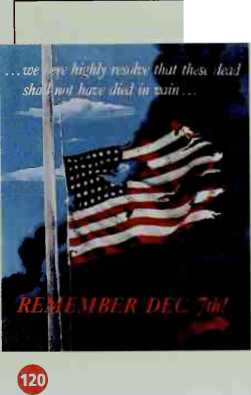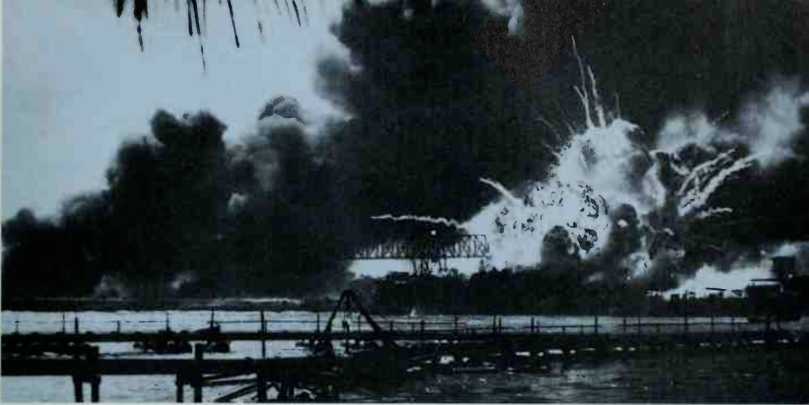As the 1940s began, war raged in Europe. But it wasn't the only hot spot on the globe. The Japanese had occupied northern Indochina in Southeast Asia in 1940 (see map on page 119). They were still on the offensive in China itself, which was teetering toward civil war between Nationalists and Communists.
Axis Alliance. Roosevelt wanted to contain the Japanese. But with all of Europe threatened by fascism, he needed to keep the United States out of a war in Asia.
Still, the two conflicts were rapidly moving closer together. In September 1940, Japan signed the Three-Power (Tri-Partite) Pact with Italy and Germany. The three countries agreed to help each other in case of a war with another power. The power was understood to be the United States. Japan hoped the pact would keep the U. S. from interfering in Asia. Germany believed it would deter the United States from joining forces with Britain.
Roosevelt intei-preted the pact as a pointed threat, but Japan was, in fact, bluffing. The Japanese were not yet keen to confi'ont the United States. They already had their hands full in China.
Roosevelt increased support for the Nationalist Chinese to prevent Japan from dominating China. But many Japanese felt the United States was denying Japan its proper rights in Asia.
Economic Embargo. The Japanese-U. S. commerce treaty had expired in January 1940 and had not been renewed by the United States. In July, President Roosevelt stmck another blow against Japans economy. He ordered restrictions on the sale of certain kinds of fuels and metals to Japan. At the same time, he insisted he was still willing to negotiate.
Talks continued through the summer of 1941. Roosevelt asked Japan to pull its military forces out of China and Indochina. The Japanese did not answer directly. Privately, they were preparing for war.
Throughout November, U. S. intelligence intercepted a number of secret messages to the Japanese ambassador (see sidebar). These messages led the State Department to believe that the Japanese would soon launch an attack somewhere against the United States. The question was where. Almost everyone thought the Japanese would hit islands such as the Philippines that were close to Japan.
Secret Fleet. On November 26, a secret Japanese task force steamed out of Hittokapu Bay. Six aircraft carriers, two battleships, and their escorts were on their way to Pearl Harbor. They were instructed to deal a "mortal blow" to the U. S. fleet in the Pacific.
Heavy clouds obscured the ships’ movements for nearly the entire journey. The fleet maintained strict radio silence. On the morning of December 7, squadrons of bomber and fighter planes took off beneath the clouds. Fixing on a radio broadcast from Honolulu, they homed in on their target.

After the attack at Pearl Harbor many people wondered how such a surprise raid could have happened. The surprise was especially hard to understand since U. S. intelligence had been reading Japanese diplomatic messages for years.
The Japanese PURPLE code had been broken in the 1930s. The decoded messages were known as “MAGIC.”
U. S. Army and Wavy intelligence shared MAGIC information. On alternate days the Army or Wavy would decode whatever messages came in. The method created confusion and may have hampered detection of the planned Japanese attack. Military intelligence was extremely cautious about MAGIC falling into the wrong hands. Only a very short list of people,
Including the president, were allowed to review MAGIC intercepts. When a decoded MAGIC message was found in the president's waste can, he was briefly taken off the list.
The Japanese decided to attack Pearl Harbor on Wovember 5. MAGIC messages then began to heat up. The Japanese ambassador to the United States was instructed that all negotiations had to end by Wovember 29. After that, the message said, "things are automatically going to happen.”
Few thought the Japanese were capable of launching a large-scale attack as far away as Pearl Harbor. Wone of MAGIC'S messages gave any clue that the port was in danger. The real clues may have been in Japanese naval messages. But that code had not yet been broken.

The USS Shaw explodes during the Japanese mid on Pearl Harbor. The next day, the United States declared war.
As the Japanese attack force—183 planes in the first wave—roared in over Oahu, most U. S. Navy personnel were enjoying a relaxing Sunday. Sailors and officers were eating breakfast or on their way to church. They weren’t expecting Japanese bombers. When the raiding planes were spotted, almost everyone thought they were U. S. aircraft.
"Yesterday, December 7, 1941—a date which will live in infamy—the United States of America was suddenly and deliberately attacked by naval and air forces of the Empire of Japan...”
— FDR, asking Congress for a declaration of war
A radar installation had even picked up the blips from the Japanese attack force early that morning. The men on duty reported the sighting to their commanding officer. His response: "Well, don’t woiTy about it.”
A Blazing Rout. The Japanese could hardly believe their luck. As they flew over Ford Island, they counted eight battleships—the Pacific fleet’s big guns—anchored like sitting ducks.
The Japanese pilots went into a bombing frenz>'. Nearly all of the battleships were seriously damaged, but none took a worse beating than the Arizona. As the attack began, several bombs slammed directly into her. While Japanese planes strafed the decks, sailors tried to man the Arizona's guns and suffocate deck fires. Battling the blazes, many caught fire themselves.
As the Arizona's crew struggled to battle the flames, another tremendous explosion rocked the ship. A bomb had blown up her powder magazines. The bow of the Arizona seemed to rise straight into the air and then crash back down into the water. Suddenly a giant ball of fire rose from the ship, a geyser of flame spurting five stories into the air. The explosion was so fierce it blew men off nearby ships. On the Arizona, four-fifths of the crew, a thousand men, died then and there.
When navy crews thought they had taken all that the Japanese could send them, another wave of planes attacked. Airfields and bases were slammed by bombs. Army fighter planes, parked in neat rows, were smashed and burned before they could take off.
In just a few hours, the fleet at Pearl Harbor was gutted. The pride of the U. S. Navy billowed in black smoke. Never in U. S. naval histoty had there been such a disaster.
President Declares War. The Japanese ambassador
Was instructed to deliver an ultimatum to the United States before the attack. But it had been decoded slowly and delivered late. The Japanese had therefore staged a "sneak attack.” President Roosevelt called the raid an act of cowardice. The attack had killed more than 2,400 people, sixty-eight of them cirilians. The United States was outraged.
On December 8, 1941, President Roosevelt asked Congress to declare war against Japan. Three day s later, Germany and Italy declared war on the United States. The nation, once sworn to neutrality, was now committed to war.




 World History
World History









